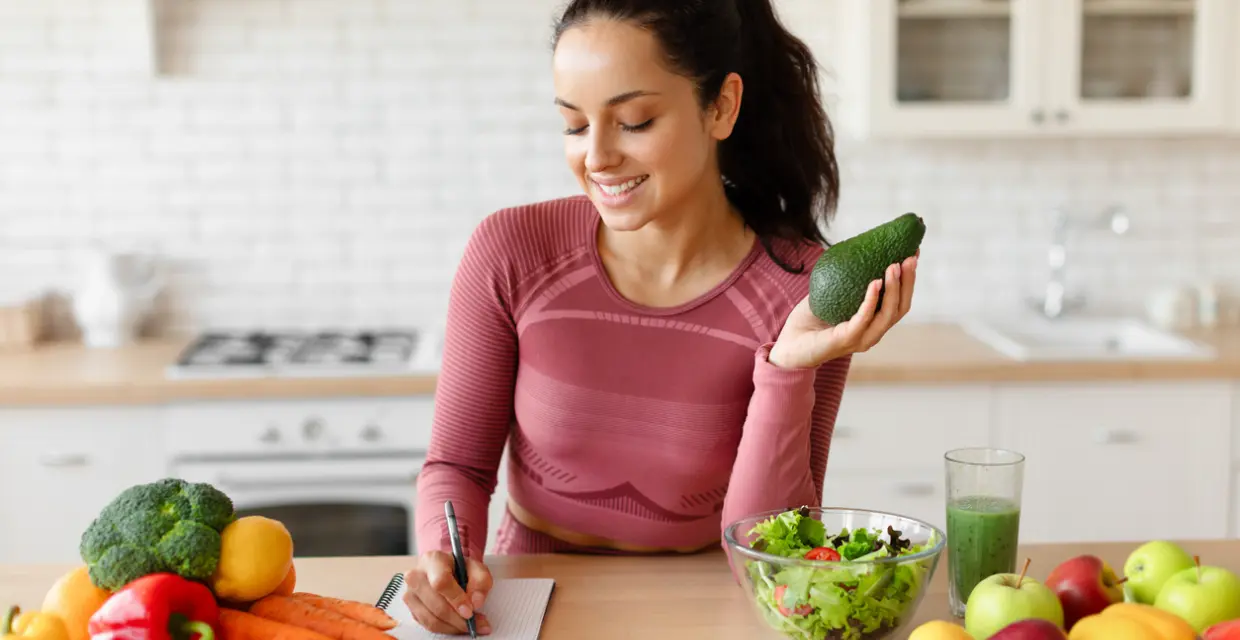Key Points
- Semaglutide reduces appetite, which aids weight loss, but can lead to inadequate nutrient intake
- Common semaglutide side effects, like nausea, bloating, diarrhea, and constipation, may also make it difficult to eat balanced meals
- This semaglutide diet plan uses lean proteins, healthy fats, and fiber-rich foods to help you lose weight and get the nutrients you need
If you're taking semaglutide (Ozempic, Wegovy, or Rybelsus) for weight loss or blood sugar management, what you eat matters just as much as the medication itself.
The right nutrition choices can enhance semaglutide's effectiveness while helping you manage potential side effects and feel your best throughout your journey.
How does semaglutide affect hunger?
One of the most noticeable effects of semaglutide is how it changes your appetite.
As a GLP-1 receptor agonist, it mimics a naturally occurring gut hormone that slows down how quickly food leaves your stomach, signals areas of the brain that regulate appetite, and helps your pancreas release insulin more effectively.
The result? Taking Ozempic and Wegovy can result in a significant decrease in hunger and food cravings. Many people feel satisfied with smaller portions and experience less interest in food between meals. This makes it easier to consume fewer calories without feeling deprived.
Challenges with diet when taking semaglutide
Semaglutide's appetite-suppressing effects are great for weight loss, but they can create some nutritional challenges.
Less hungry
With reduced hunger, many people may skip meals or eat far less than their body needs, risking inadequate intake of essential nutrients, including protein, vitamins, and minerals.
Side effects
The medication's side effects add another layer of difficulty. Semaglutide side effects include nausea, bloating, vomiting, diarrhea, and constipation. These symptoms are typically worse when starting the medication or increasing doses.
It can be hard to get balanced, timely meals when you’re battling nausea or digestive discomfort because eating becomes unappealing, even when your body needs fuel.
However, skipping meals or avoiding nutritious foods can worsen side effects and compromise your health goals. This is why having a structured meal plan becomes essential for success on semaglutide.
Tips to navigate a semaglutide diet
So how do you eat well while managing the challenges of being on semaglutide? The key is choosing foods that work with the medication while minimizing digestive discomfort.
Registered Dietitian, Rita Faycurry, RD, shares a few tips:
- Prioritize protein at every meal to preserve muscle mass and control hunger. Focus on lean sources like skinless chicken, fish, and plant-based options such as lentils and tofu.
- Embrace fiber-rich foods like non-starchy vegetables and fruits, which help slow carbohydrate absorption and boost satiety.
- Choose complex carbohydrates from whole grains like brown rice, quinoa, and oats over refined grains for sustained energy without blood sugar spikes.
- Eat smaller, more frequent meals throughout the day rather than three large meals, if you prefer, as this may be more comfortable since semaglutide slows digestion.
- Stay well-hydrated by drinking water consistently throughout the day, especially if you experience any gastrointestinal side effects.
- Limit foods that worsen symptoms, such as high-fat fried foods, spicy foods, sugary beverages, processed foods, and alcohol, which can aggravate digestive discomfort.
Please note: The following 7-day meal plan is based on a total of 1,400-1,600 calories per day. However, everyone's needs are unique, and the right balance of foods depends on your weight loss goals, activity level, age, and other individual factors.
7-day semaglutide diet plan
This 7-day meal plan is designed to work with semaglutide by providing balanced, nutrient-dense meals that won't overwhelm your reduced appetite.
You'll find lean proteins, fiber-rich vegetables, and complex carbohydrates portioned to keep you satisfied while supporting your weight loss goals.
Each day includes three meals and snacks designed to be anti-inflammatory and gentle on your digestive system. It also offers flexible vegetarian alternatives and is simple enough to help you eat healthy when you’re busy.
📅Day 1
Breakfast
Oatmeal with berries. Cook ½ cup of oatmeal with water or your choice of skim milk or plant-based milk (1 cup). Top with ¾ cup fresh blueberries and 2 teaspoons of pumpkin seeds for a satisfying crunch and added nutrition.
Mid-morning snack
Cottage cheese and veggies. ¼ cup of regular cottage cheese alongside ½ cup of cherry tomatoes and ½ cup of cucumber slices for a refreshing, protein-rich snack.
Lunch
Asian-inspired chicken and veggie stir-fry bowl. Stir-fry 3 oz chicken breast with ½ cup each of broccoli and carrots in 2 tablespoons of olive oil. Add ginger, garlic, soy sauce, red chili flakes (optional), and salt. Top with 1 tablespoon of sesame seeds for extra texture, flavor, and nutrients. Serve over ½ cup of brown rice.
🌱 Vegetarian alternative: Swap chicken with chickpeas.
Afternoon snack
Apple slices with peanut butter. Slice 1 medium apple and pair it with 2 tablespoons of peanut butter.
Dinner
Lean beef and veggie skewers. Thread 6 oz of lean beef cubes onto skewers, alternating with chunks of bell peppers, mushrooms, and onions. Brush with 2 tablespoons of olive oil and season to taste with your favorite herbs and spices. Grill or broil the skewers, turning occasionally, until the beef reaches your desired doneness and the vegetables are slightly charred and tender (about 10-12 minutes).
🌱 Vegetarian alternative: Replace the beef with tofu cubes.
💡Tips:
- If using wooden skewers, soak in water for 30 minutes before to prevent burning.
- Optional dessert: frozen grapes.
📅 Day 2
Breakfast
Veggie & cheese egg scramble. Scramble 2 whole eggs in 1 teaspoon of olive oil. Add ½ cup of diced bell peppers, ½ cup of chopped spinach, and 2 tablespoons of shredded cheddar cheese. Season with black pepper and a pinch of salt. Serve with 1 slice of whole-grain toast and a mandarin orange.
💡Tip: The vitamin C from the orange helps your body absorb the iron from the spinach better.
Mid-morning snack
Enjoy 1 cup of steamed edamame, sprinkled with a pinch of sea salt for a protein-rich, fiber-filled snack.
Lunch
Mediterranean turkey lettuce wraps. Season 4 oz of ground turkey with oregano, garlic powder, and a pinch of cumin. Cook until browned and divide among 3-4 large romaine lettuce leaves. Top with diced tomatoes, cucumber, red onion, 2 tablespoons of crumbled feta cheese, and a drizzle of 1 tablespoon olive oil mixed with lemon juice. Serve with ½ cup of cooked quinoa on the side.
🌱 Vegetarian alternative: Replace the turkey with white beans (cannellini).
Afternoon snack
Carrot sticks with hummus. Dip 1 cup of carrot sticks into 3 tablespoons of hummus.
Dinner
Baked cod with roasted vegetables. Season a 5-oz cod fillet with lemon juice, dill, and black pepper. Bake at 400°F for 12-15 minutes until flaky. Serve alongside roasted vegetables: toss 1 cup of zucchini chunks and ½ cup of cherry tomatoes with 2 tablespoons of olive oil, Italian seasoning, and a sprinkle of Parmesan cheese. Roast at 425°F for 20-25 minutes. Add ½ cup of roasted baby potatoes for a complete meal.
🌱 Vegetarian alternative: Replace the fish with steamed lentils.
📅 Day 3
Breakfast
Cottage cheese breakfast bowl. 1 cup of cottage cheese topped with ½ cup of sliced peaches or strawberries. Top with 1 tablespoon of chopped walnuts and a drizzle of honey. Serve on top of 1-2 slices of whole-grain toast.
Mid-morning snack
Tuna salad toast. Canned tuna mixed with a little mayo or nonfat Greek yogurt with diced or grated cucumber.
Lunch
Grilled shrimp Caesar salad. Season 4 oz of shrimp with garlic powder, lemon juice, and black pepper. Grill or sauté in 1 teaspoon of olive oil for 2-3 minutes per side until pink and cooked through. Serve over 2 cups of chopped romaine lettuce with 2 tablespoons of light Caesar dressing, 2 tablespoons of grated parmesan cheese, and ½ cup of whole-grain croutons.
🌱 Vegetarian alternative: Replace the shrimp with grilled mushrooms.
💡Tip: Replace the croutons with a handful of pumpkin seeds for crunch and healthy fats without the starchy carbohydrates.
Afternoon snack
1 small banana with 1 tablespoon of peanut butter.
Dinner
Sheet-pan herb-crusted pork with roasted vegetables. Toss 1½ cups of halved Brussels sprouts and ¾ cup of cubed sweet potato with 1 tablespoon of olive oil, salt, and pepper. Roast at 400°F for 15 minutes. Season a 4-oz pork tenderloin with rosemary, thyme, garlic powder, and black pepper. Push vegetables to the sides, add the pork to the center, and roast for 20-25 minutes more until pork reaches 145°F. Let rest 5 minutes before slicing.
🌱 Vegetarian alternative: Replace the pork with added veggies, like butternut squash, cauliflower steak, or a thick-sliced eggplant.
📅 Day 4
Breakfast
Spinach and feta egg white omelet. Whisk together 4 egg whites with a pinch of salt and pepper. Cook in 1 teaspoon of olive oil over medium heat. When almost set, add 1 cup of fresh spinach and 2 tablespoons of crumbled feta cheese. Fold and cook until the cheese melts. Serve with 1 slice of whole-grain toast and a side of ½ cup of cantaloupe cubes.
Mid-morning snack
Hummus with cucumber slices. Dip 1 cup of cucumber slices or carrot sticks into 3 tablespoons of hummus.
Lunch
Lemon-herb baked tilapia with quinoa. Season a 5-oz tilapia fillet with lemon juice, fresh dill, garlic powder, and black pepper. Bake at 400°F for 10-12 minutes until the fish flakes easily. Serve over ½ cup of cooked quinoa with 1 cup of steamed green beans tossed with 1 teaspoon of olive oil and lemon zest.
🌱 Vegetarian alternative: Use 1 cup of drained, canned cannellini or navy beans tossed with lemon juice, dill, garlic powder, and black pepper. Warm through in a skillet with 1 teaspoon of olive oil.
Afternoon snack
Pear or apple with almonds. Enjoy 1 medium pear with 10-12 raw almonds for a satisfying combination of fiber and healthy fats.
Dinner
Turkey meatballs with zucchini noodles. Mix 5 oz of lean ground turkey with 1 minced garlic clove, Italian seasoning, salt, and pepper. Form into 6-8 small meatballs and bake at 400°F for 15-18 minutes until cooked through. Meanwhile, spiralize 2 medium zucchini into noodles and sauté in 1 tablespoon of olive oil for 2-3 minutes until just tender. Serve meatballs over zucchini noodles with ½ cup of marinara sauce and 1 tablespoon of grated parmesan cheese.
🌱 Vegetarian alternative: Make mushroom "meatballs" by finely chopping 2 cups of mushrooms and mixing with 1 minced garlic clove, Italian seasoning, 3 tablespoons breadcrumbs, 1 egg, salt, and pepper. Form into 6-8 balls and bake at 400°F for 15-18 minutes.
💡Tip: Zucchini noodles are a lower-carb, lighter alternative to pasta that won't leave you feeling overly full.
📅 Day 5
Breakfast
Overnight oats with chia seeds. Mix ½ cup of rolled oats with 1 tablespoon of chia seeds, ¾ cup of unsweetened almond milk, and ½ teaspoon of vanilla extract in a jar. Refrigerate overnight. In the morning, top with ½ cup of sliced peaches or apples and 1 tablespoon of chopped pecans or walnuts.
Mid-morning snack
2 rice cakes with almond butter.
Lunch
Chicken avocado salad wrap. Fill a whole-wheat tortilla with 3 oz of grilled chicken breast strips, ¼ sliced avocado, 1 cup of mixed greens, diced tomatoes, and shredded carrots. Drizzle with 1 tablespoon of light ranch dressing or Greek yogurt-based dressing. Roll tightly and slice in half.
🌱 Vegetarian alternative: 3 oz crumbled tempeh sauteed with taco seasoning or Italian herbs, or ½ cup seasoned black beans.
Afternoon snack
Roasted chickpeas. Enjoy ½ cup of roasted chickpeas seasoned with paprika and garlic powder for a crunchy, protein-packed snack.
💡Tip: Make a big batch of roasted chickpeas on meal prep day. They stay crispy for 3-4 days when stored in an airtight container.
Dinner
Baked lemon-garlic salmon with roasted vegetables and wild rice. Season a 5 oz salmon fillet with lemon juice, minced garlic, fresh dill, and black pepper. Bake at 400°F for 12-15 minutes until the salmon flakes easily. Serve with 1 cup of roasted mixed vegetables (toss frozen mixed vegetables with 1 teaspoon olive oil, salt, and pepper, then roast for 15-20 minutes) and ½ cup of cooked wild rice.
🌱 Vegetarian alternative: 5 oz of extra-firm tofu, marinated in the same lemon-garlic-dill marinade, then baked.
📅 Day 6
Breakfast
Veggie scramble with whole-grain toast. Scramble 2 whole eggs with ½ cup diced tomatoes, ½ cup chopped mushrooms, and ¼ cup diced onions in 1 teaspoon of olive oil. Season with salt, pepper, and a pinch of paprika. Serve with 1 slice of whole-grain toast and ½ cup of fresh blueberries.
Mid-morning snack
Banana with cashew butter. Slice 1 small banana and spread with 1 tablespoon of cashew butter for a creamy, satisfying snack. If you don’t have cashew butter, use any nut butter you have on hand.
Lunch
Tuna quinoa bowl. Mix one 5-oz can of water-packed tuna (drained) with ½ cup cooked quinoa, 1 cup baby spinach, ½ cup diced cucumber, ¼ cup shredded carrots, and 5 cherry tomatoes (halved). Dress with 1 tablespoon olive oil mixed with lemon juice and a pinch of oregano.
Afternoon snack
Cottage cheese with raspberries. Have a ½ cup of low-fat cottage cheese topped with ½ cup fresh raspberries and a sprinkle of cinnamon.
Dinner
Hearty lentil and vegetable stew. In a pot, sauté ½ cup diced onions, ½ cup diced carrots, and 1 minced garlic clove in 1 tablespoon olive oil for 5 minutes. Add 1 cup canned lentils (drained and rinsed), 1 cup low-sodium vegetable broth, ½ cup diced tomatoes, 1 cup chopped cauliflower florets, ½ teaspoon cumin, ½ teaspoon dried thyme, salt, and pepper. Simmer for 15-20 minutes until the vegetables are tender. Serve with ½ cup cooked couscous or quinoa on the side.
💡Tip: Add beef cubes or shredded chicken if you prefer meat. If you prefer dried, uncanned lentils, soak them overnight, and cook a batch in advance during meal prep.
📅 Day 7
Breakfast
Greek yogurt power bowl. Mix 1 cup plain Greek yogurt with 1 tablespoon ground flaxseed, ½ cup sliced strawberries, 1 tablespoon slivered almonds, and a drizzle of honey (½ teaspoon). Sprinkle with cinnamon.
💡Tip: Add protein powder of your choice if you prefer more protein.
Mid-morning snack
Cantaloupe with lime. Enjoy 1½ cups of fresh cantaloupe cubes with a squeeze of fresh lime juice for a refreshing, hydrating snack. Swap the cantaloupe with watermelon if you prefer.
Lunch
Mediterranean chickpea bowl. Combine ¾ cup canned chickpeas (drained and rinsed) with 2 cups mixed greens, ½ cup diced cucumber, ¼ cup diced red onion, 5 kalamata olives, and 2 tablespoons crumbled feta cheese. Dress with 1 tablespoon olive oil mixed with lemon juice and dried oregano. Serve with ½ small whole-wheat pita.
Afternoon snack
Hard-boiled egg with cherry tomatoes. 1 hard-boiled egg with 1 cup cherry tomatoes
Dinner
Baked tilapia tacos with cabbage slaw. Season 5 oz of tilapia with chili powder, cumin, garlic powder, and lime juice. Bake at 400°F for 10-12 minutes. Flake the fish and serve in 2 small corn tortillas with ½ cup shredded cabbage slaw (mix shredded cabbage with lime juice, cilantro, and a pinch of salt). Optional: Top with ¼ sliced avocado and a dollop of Greek yogurt or light sour cream.
🌱 Vegetarian alternative: Toss cauliflower florets or sweet potatoes with the same spice mix (chili powder, cumin, garlic), roast until crispy and golden.
Optional dessert: Dark chocolate-covered strawberries. Dip 5 large strawberries in 1 oz of melted dark chocolate (70% cacao or higher). Let cool on parchment paper until the chocolate sets.
A registered dietitian can provide a personalized semaglutide diet plan built for your specific needs.
Meal prep tips
Once you understand which foods work best for your body, meal preparation becomes your secret weapon for staying on track.
Here are some tips to get you started:
- Choose a consistent prep day each week for grocery shopping and meal preparation that fits your schedule.
- Batch cook your proteins like grilled chicken, baked fish, or seasoned turkey, then divide them into individual containers.
- Prep complex carbohydrates such as brown rice, quinoa, or sweet potatoes in larger portions for the week.
- Wash and chop vegetables in advance so they're ready to add to meals or eat as snacks.
- Invest in quality storage containers that keep food fresh and are appropriately portioned for your needs.
- Make seasonings your friends. Experiment with different types of low-sodium or no-sodium seasoning mixes to add flavor and interest.
- Start simple by prepping components (proteins, grains, and chopped vegetables) that you can mix and match throughout the week rather than full meals.
- Label containers with the date and contents to prevent waste and ensure food safety.
Remember that everyone's experience with semaglutide is unique. While the 7-day meal plan provides a solid foundation, listen to your body and adjust based on what works best for you.
Find the right semaglutide diet for you with a registered dietitian who accepts your insurance.
The views expressed by authors and contributors of such content are not endorsed or approved by Fay and are intended for informational purposes only. The content is reviewed by Fay only to confirm educational value and audience interest. You are encouraged to discuss any questions that you may have about your health with a healthcare provider.
Source
- Mechanisms of GLP-1 Receptor Agonist-Induced Weight Loss: A Review of Central and Peripheral Pathways in Appetite and Energy Regulation (May 17, 2025)
https://www.sciencedirect.com/science/article/pii/S0002934325000592











